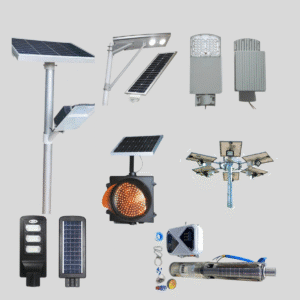How Solar Street Lights Are Made – Complete Manufacturing & Assembly Guide
Solar street lights are a popular off-grid lighting solution, ideal for highways, gardens, rural areas, and smart city projects. But have you ever wondered how they are actually made?

This guide covers the step-by-step manufacturing process, key components involved, and final assembly—everything you need to know if you’re considering entering the solar light industry or just want to understand how this smart technology works.
🌌 Components Required to Make a Solar Street Light
A high-quality solar street light typically includes the following main parts:
- Solar Panel – Converts sunlight into electricity
- Battery – Stores power for night use
- LED Light – Provides illumination
- Solar Charge Controller – Regulates voltage and protects the battery
- Housing/Body – Holds all components together
- Pole & Mounting Kit – Supports and positions the light unit
🔧 Step-by-Step Manufacturing Process
- Design & Specification
Engineering begins with defining the wattage, battery capacity, solar panel size, and backup time required for the specific application. - Solar Panel Sourcing
Panels are sourced or assembled based on the energy requirement. For instance, a 40W street light may require a 80–120W panel. Panels are tested for voltage, current, and insulation. See AUTIGO Solar Panels. - Battery Preparation
Lithium-ion or LiFePO4 batteries are commonly used. Batteries are matched with controller and LED driver specs. Learn more at AUTIGO Batteries. - LED & Driver Assembly
The LED module is assembled with a current driver to ensure stable power supply. High lumen output and optical lenses are added for beam spread. Check AUTIGO LED Lights. - Controller Configuration
Controllers are programmed for dusk-to-dawn operation, motion sensing, and battery protection. Visit AUTIGO Controllers. - Enclosure Manufacturing
Aluminum or ABS housings are fabricated using CNC or casting machines. These are then powder-coated for durability. Housing examples are available on AUTIGO. - Wiring & Integration
Components are integrated using MC4 connectors and sealed with IP65 waterproofing standards. Functional testing is conducted. - Pole & Bracket Assembly
The entire unit is mounted on a galvanized pole with the correct bracket angle. View AUTIGO Poles. - Testing & Packaging
Final QC tests include light output, solar charging performance, and runtime test. Approved lights are packed for delivery with mounting instructions.
📅 How Long Does It Take to Make One?
For an experienced solar factory, it takes 20–45 minutes to assemble one unit depending on integration level (semi-integrated or all-in-one). Custom orders may take longer based on controller settings and housing material.
💳 Manufacturing Cost Estimate
The cost of a 12W–40W solar street light ranges from ₹3,500 to ₹8,800 (for OEM manufacturers). Components like lithium battery and MPPT controller influence pricing the most.
🌟 Final Thoughts
Solar street light production combines clean energy engineering with efficient assembly. By choosing reliable components from trusted suppliers like AUTIGO, manufacturers can ensure long-lasting performance with minimal maintenance.
If you’re a solar distributor, OEM, or EPC company looking for private-label or bulk orders, get in touch with AUTIGO for factory pricing and support across India.
